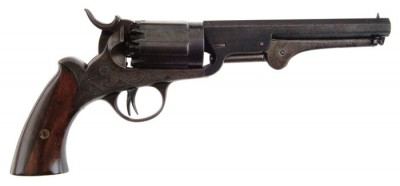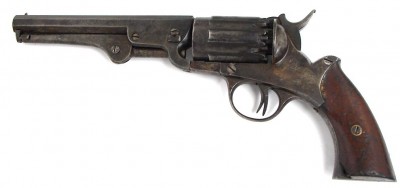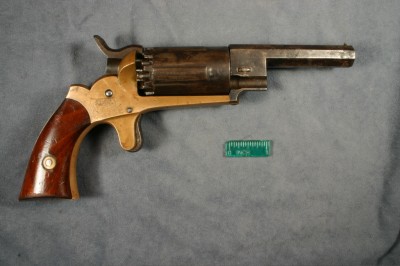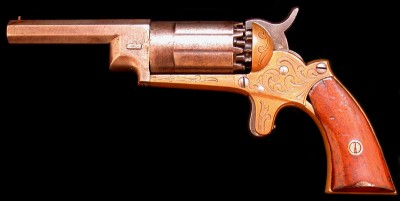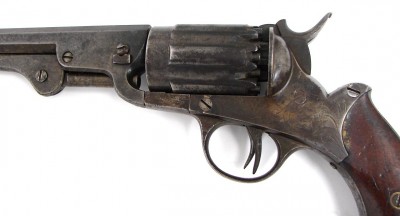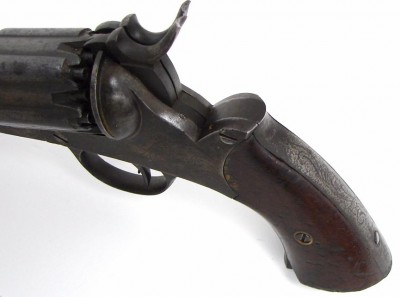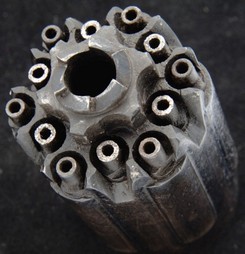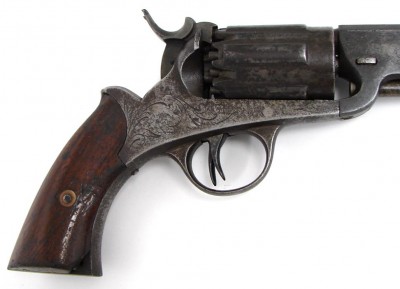| Název: Name: | John Walch Navy Model | John Walch Navy Model |
| Originální název: Original Name: | Revolver M 1859 Navy Model | |
| Kategorie: Category: | pistole / revolver | pistol / revolver |
| Výrobce: Producer: | Union Knife Company, Naugatuck, Connecticut, USA | |
| Technické údaje: Technical Data: | ||
| Hmotnost nenabité zbraně: Weight Unloaded: | - kg | - lb |
| Ráže: Calibre: | .36 | |
| Náboj: Cartridge: | .36 | |
| Délka: Length: | 320 mm | 1ft 0,60in |
| Délka hlavně: Barrel Length: | 152 mm | 6 |
| Kapacita zásobníku: Magazine Capacity: | 12 | |
| Výkony: Performance: | ||
| Rychlost střelby: Rate of Fire: | - ran/min | - rpm |
| Úsťová rychlost: Muzzle Velocity: | - m/s | - ft/s |
| Uživatelské státy: User States: | ||
| Poznámka: Note: | - | - |
| Zdroje: Sources: | - | |
USA - Walch revovery
perkusní revolver
The desire to fire as many shots as possible is about as old as firearms themselves. But it didn't become more common until around the mid-19th century, and the most famous result of these efforts is the revolver. Before the introduction of metal-cased cartridges, there were efforts to make repeating rifles, but the results were not very successful and did not catch on. But also the number of shots in the cylinder of a revolver is limited (usually to 5 - 6 shots) and many people didn't seem to care, so they tried to increase that number. One way was to increase the diameter of the cylinder, but this is limited by both the size and especially the weight, so it doesn't work very well (this is the reason that even today the number hasn't increased substantially) and the later Lefauches cartridge revolvers with multiple chambers are more or less a pun. But another approach was thought of by J.P. Lindsay when the percussion revolver was a novelty, and he was inspired by something tried earlier with rifles, that is, having two cartridges behind each other in the chamber. Together with John Walch, they then designed a fore-end that used this system, which was subsequently produced in small numbers by Springfield Armory, but it did not catch on in the early days of metallic cartridge fore-ends. However, a revolver was constructed on a similar principle and is known as the "1859 Walch Navy Revolver", I have not been able to find out why Lindsay's name dropped out of the name, but the guns were sold under the name of John Walch, it was an interesting revolver in .36 with a six chambered cylinder, but each chamber had two primer pistols at the rear, one had a channel leading straight to the rear of the cylinder, the other had a channel leading to about halfway down the chamber, which can be seen from the outside by the projection on the cylinder. The chamber was loaded with powder and a bullet with a plug, then again with powder and another bullet with a plug. There were thus 12 shots instead of the usual 6. The revolver was fitted with two percussion taps and two triggers, the left trigger being slightly to the rear, so that on the trigger being pulled the right trigger was pulled first and fired the front cartridge in the chamber, then on the next squeeze the left trigger and left tap fired the rear cartridge. The revolver was a single action, so this was followed by pulling both triggers (in one motion) which simultaneously rotated the cylinder and the whole cycle could be repeated. At first glance there is nothing too noticeable about the revolver, the cylinder is slightly longer, there are longitudinal protrusions on the surface, but neither of these things are too noticeable. The two hammers are cocked when viewed from the side (unless one is cocked and the other cocked) and the triggers don't deviate too far from each other. Thus, in the pictures, the layman can easily confuse this interesting and elegant weapon with the common revolvers of the time. About 200 of the .36 caliber Walch guns were made (ordered by Walch) by the Union Knife Company of Naugatuck, Connecticut, and all known revolvers have a steel frame, and a bow. The barrel is octagonal, and on all specimens is 6 inches long. It is occasionally suggested that these revolvers were used in the Civil War, but nothing can be substantiated, and theoretically they may have been used as private weapons by both sides.
In addition to the aforementioned .36 caliber revolver, Walch also had another similar gun made, this time in larger numbers of about 2,000 (3,000 is also reported), but in the smaller .31 caliber as the "Walch Pocket Revolver", a gun made sometime between 1859 and 1862 by the New Haven Arms Company, known for its production of Henry system repeating rifles. This smaller revolver had a barrel about 3.5 inches long, again octagonal, but the cylinder had only 5 chambers and the gun was therefore a 10-shot. The frame was apparently usually bronze, but I have also come across mention of an "iron" frame. The trigger does not have a bow and it is not clear from the available photos whether it is again split or the system is somehow changed, but it is usually stated that there is only one trigger, how the split into the two parts in a given chamber is done is a mystery to me from the literature available. The percussion cock is again double according to the literature, but this cannot be confirmed from photographs. Here too it is not very likely that the weapon was commonly used by the military. The known examples were originally blued and some had a simple engraving on the back of the frame, the larger revolvers usually do not have the maker's markings, the smaller "pocket" revolvers sometimes have the inscription "Walch Firearms of New YorkNew York, state, United States New York, Pat. Feb. 8, 1859." Thus the name of the manufacturer (but the company had the guns made) and the date of patenting. The guns are now collectible and sought after rarities. While it is a gun that did not become widespread and was displaced by revolvers chambered for metallic cartridges, it is certainly an interesting gun and one that brought some advantage to its owner in its day. Its disadvantages were, of course, more complicated and difficult reloading, more complicated production and thus higher price.
Source : http://oldguns.net/q&a1_02.htm
www.collectorsfirearms.com
http://proofhouse.com/win/winchester.htm
www.gregmartinauctions.com
http://papke.med.ufl.edu/curios/Walch01.jpg
from the same sources are also photos
In addition to the aforementioned .36 caliber revolver, Walch also had another similar gun made, this time in larger numbers of about 2,000 (3,000 is also reported), but in the smaller .31 caliber as the "Walch Pocket Revolver", a gun made sometime between 1859 and 1862 by the New Haven Arms Company, known for its production of Henry system repeating rifles. This smaller revolver had a barrel about 3.5 inches long, again octagonal, but the cylinder had only 5 chambers and the gun was therefore a 10-shot. The frame was apparently usually bronze, but I have also come across mention of an "iron" frame. The trigger does not have a bow and it is not clear from the available photos whether it is again split or the system is somehow changed, but it is usually stated that there is only one trigger, how the split into the two parts in a given chamber is done is a mystery to me from the literature available. The percussion cock is again double according to the literature, but this cannot be confirmed from photographs. Here too it is not very likely that the weapon was commonly used by the military. The known examples were originally blued and some had a simple engraving on the back of the frame, the larger revolvers usually do not have the maker's markings, the smaller "pocket" revolvers sometimes have the inscription "Walch Firearms of New YorkNew York, state, United States New York, Pat. Feb. 8, 1859." Thus the name of the manufacturer (but the company had the guns made) and the date of patenting. The guns are now collectible and sought after rarities. While it is a gun that did not become widespread and was displaced by revolvers chambered for metallic cartridges, it is certainly an interesting gun and one that brought some advantage to its owner in its day. Its disadvantages were, of course, more complicated and difficult reloading, more complicated production and thus higher price.
Source : http://oldguns.net/q&a1_02.htm
www.collectorsfirearms.com
http://proofhouse.com/win/winchester.htm
www.gregmartinauctions.com
http://papke.med.ufl.edu/curios/Walch01.jpg
from the same sources are also photos
Reklama
several photos of the design details of the Walch .36 (Navy) revolver
source is the same as above
pohled na oba bicí kohouty, pravý je ten který bije první, je v ose výstupku na válci, kterým se zažehuje první náplň
pohled zprava, opět je dobře viidět dvě spouště a rovněž výstupek na válci pro zapálení předního náboje
source is the same as above
pohled na oba bicí kohouty, pravý je ten který bije první, je v ose výstupku na válci, kterým se zažehuje první náplň
pohled zprava, opět je dobře viidět dvě spouště a rovněž výstupek na válci pro zapálení předního náboje
Join us
We believe that there are people with different interests and experiences who could contribute their knowledge and ideas. If you love military history and have experience in historical research, writing articles, editing text, moderating, creating images, graphics or videos, or simply have a desire to contribute to our unique system, you can join us and help us create content that will be interesting and beneficial to other readers.
Find out more